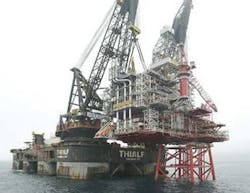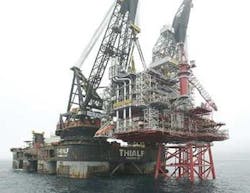Offshore Europe
Independents sustaining UKCS spending
Scottish Enterprise's Energy Team, in their latest Spends & Trends CD ROM, foresee £32-40 billion of investments across the UK shelf between 2002 and 2006. Their conclusions are drawn largely from recent UK government/ industry body polls of operators' intentions. Under the most optimistic oil price scenario ($25/bbl), these suggest:
- Close to 60 exploration and appraisal wells to be drilled annually in UK waters between now and 2006
- 96 incremental developments from existing field complexes, with 64 probable and 84 possible new field developments
- Annual operating expenditure over the next five years of £3.6-4 billion.
Most of the new projects will likely be small-scale, along the lines of Marathon's current 12-km, single-well subsea tieback of Braemar's 115-bcf, 10-MMbbl gas-condensate reservoir to the East Brae platform. This is bad news for Britain's few surviving fabrication yards. The latest casualty was McDermott's jacket specialist site in Ardersier, northern Scotland, recently wound down following a dearth of offshore orders over the past two years.
A few more substantial hardware projects are coming up for bid, led by the 800-MMbbl Buzzard development in the central North Sea. Generally, the super majors will continue to stump up the largest investments, Scottish Enterprise says, but the sector's future looks to be in the hands of independents such as Talisman, Kerr-McGee, and Buzzard operator PanCanadian.
Others building a power base in the UK include Gaz de France in the southern gas basin and Canadian Natural Resources, which recently paid $120 million for a package of Kerr-McGee assets, including operatorship of the declining Lyell, Murchison, and Ninian fields. Another new entrant is GlobalSantaFe, which has just teamed up with DNO to drill satellites in the Heather area using its semisubmersible Glomar Arctic IV.
Ringhorne in place, Valhall delayed
Heerema's Thialf vessel recently completed the heaviest lift operation to date on the Norwegian shelf, the 11,400-ton deck and drilling facilities for Esso's Ringhorne platform in the North Sea. It also then positioned the 1,200-person living quarters, built by Sweden's Emtunga, onto the deck. Otherwise the 24-slot platform is largely a Heerema production.
Ringhorne was first developed last year through subsea wells tied into Esso's Balder floating production vessel, which came onstream in 1999. The new platform will export oil to this FPU, receiving lift gas in return. It should come onstream in December. London analysts Scan-boss put Ringhorne's recoverable oil at 280 MMbbl. Subsea 7 and Technip-Coflexip have also been contracted to install the Ringhorne Jurassic to Jotun, along with Balder Gas rigid flowlines, flexibles, and jumpers next summer.
Another heavy-duty installation, BP's Valhall water injection platform, slipped behind schedule due to unexpected problems piling the 4,000-ton jacket, built by Aker Verdal. BP was looking for a rig to take on drilling of five of the piling holes and hoped to have Saipem installation barge S7000 back on site this month to complete the job. When the 13,500-ton steel platform is in place, it will be bridge linked to Valhall's existing wellhead platform.
Heidrun hub for gas satellites
Statoil's Heidrun TLP, which came onstream as an oil producer in 1995, could in the future act as a hub for gas developments in the Norwegian Sea. A Det Norske Veritas study of the platform's topside weight reserves, commissioned by Statoil, is due to be completed next month. Findings so far are positive, although a new pipeline would be needed to connect Heidrun to Norway's gas trunkline network.
One potential client could be BP's yet-to-be-sanctioned Skarv project to the north. BP had hoped to issue a development plan this month but was frustrated by uncertainties over available export capacity through the Åsgard Transport System. If ullage there does prove to be limited, it may opt instead for a subsea scheme for Skarv tied back to Heidrun. It is also considering shipping Skarv's gas through a proposed pipeline from Norsk Hydro's undeveloped Ormen Lange field, viewed as a potential bulk supplier to the UK market from 2007 onwards.
Around 100 km west of Ormen Lange, Hydro was planning to drill the deepest well to date on the Norwegian shelf, in 1,800 m of water on the Solsikke prospect. A successful outcome could lead to a new field development hub in this area. But Norway's drilling track record in virgin areas has been poor this year. The latest failures include Conoco's Akkar well, which was attempting to prove a northern extension of the productive Tampen area fields in the North Sea, and Phillips' dry well on the Surlasson prospect.
Call for greater gas connectivity
BP is the latest major to call for new spur lines to increase connections between UK and Nor-wegian gas trunklines. The suggestion, aired at Offshore Northern Seas Stavanger, coincided with a new initiative by government/industry bodies from both countries, Pilot and Kon-Kraft, to speed up field development within a 60-km tranche of acreage either side of the North Sea median line. The aim is to pool infrastructure resources and technology practices to tap 13 Bboe of undeveloped assets. Both groups have identified 65 commercial and 82 technical finds within this band.
The really big prize for all concerned is the UK's future gas market, with indigenous UK supplies predicted to lag demand by 2006 onwards. Some groups have already attempted to address the imbalance through proposed new pipelines from Draupner in the Norwegian North Sea and Den Helder in The Netherlands, both terminating at the Bacton terminal on the eastern English coast. The Isle of Grain east of London may also become the site of a new LNG import terminal.
Theoretically, claim analysts Wood Mackenzie, Ormen Lange could provide 18 bcm/yr of the 75 bcm needed annually in Britain by the end of the decade. This might feed through existing Norway-UK trunkline links such as Vesterled and Frigg. More ullage will also become available through the UK lines cited by BP (Miller, Sage, etc.) as their host fields deplete. Wood Mackenzie believes there could be 60 bcm of disposable capacity through existing systems alone by 2010. If the new lines (30 bcm or so) and the LNG terminal are also factored in, the total available would exceed UK needs.

